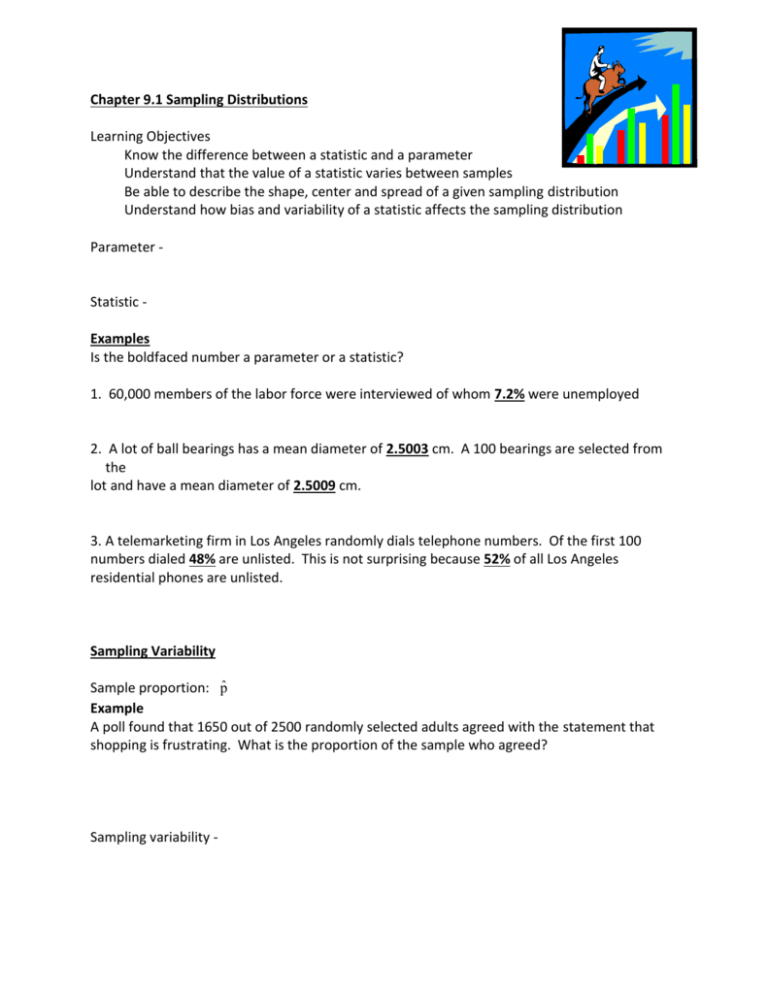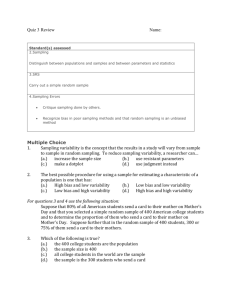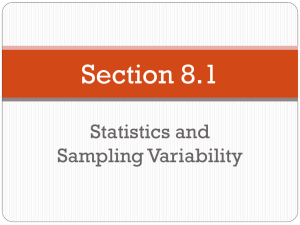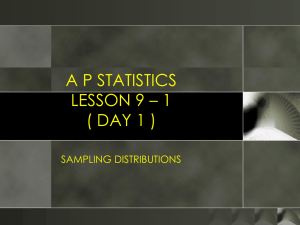9.1-9.2 notes - how-confident-ru
advertisement

Chapter 9.1 Sampling Distributions Learning Objectives Know the difference between a statistic and a parameter Understand that the value of a statistic varies between samples Be able to describe the shape, center and spread of a given sampling distribution Understand how bias and variability of a statistic affects the sampling distribution Parameter - Statistic Examples Is the boldfaced number a parameter or a statistic? 1. 60,000 members of the labor force were interviewed of whom 7.2% were unemployed 2. A lot of ball bearings has a mean diameter of 2.5003 cm. A 100 bearings are selected from the lot and have a mean diameter of 2.5009 cm. 3. A telemarketing firm in Los Angeles randomly dials telephone numbers. Of the first 100 numbers dialed 48% are unlisted. This is not surprising because 52% of all Los Angeles residential phones are unlisted. Sampling Variability Sample proportion: p̂ Example A poll found that 1650 out of 2500 randomly selected adults agreed with the statement that shopping is frustrating. What is the proportion of the sample who agreed? Sampling variability - Applet: http://www.rossmanchance.com/applets/Reeses/ReesesPieces.html With a sample size of 25, I repeatedly Generated samples. What is the mean of the distributuion? What is the spread of the entire distribution? With a sample size of 100, I repeatedly Generated samples. What is the mean of the distributuion? What is the spread of the entire distribution? So what do we notice: 1- 2- Sampling Distribution Describing Sampling Distributions 1. 2. 3. 4. Unbiased Statistic - a statistic is unbiased if the mean of the sampling distribution is _________ to the true value of the parameter being estimated Variability of a statistic 1. Is described by the spread of its sampling distribution. 2. This spread is determined by the sampling design and the size of the sample. 3. Larger samples give smaller spread. High bias; low variability Low bias; high variability High bias; high variability Low bias; low variability Formulas we need: To calculate the standard deviation for proportion 𝑝(1 − 𝑝) 𝜎=√ 𝑛 Example 60% of people find clothes shopping frustrating. Find the proportion of people that fall within 2 standard deviations of the mean for samples of size n =100 Step 1: Step 2: n = 2500 Step 1: Step 2: Why does the size of the population have little influence on how statistics from a random sample behave? Ch 9.2 Sample Proportions Learning Objectives Know the characteristics of the sampling distribution of p̂ Know when to use the normal approximation for p̂ Be able to solve problems using the normal approximation for p̂ Sampling distribution of p̂ Choose an SRS of size n from a large population, then: 1. 2. 3. In order to analyze data ,we have to make some assumptions before we begin our calculations! Assumption 1 -The data was taken from a random sample Assumption 2 -The standard deviation _________ for ______ can only be used when the population is at least 10 times as large as the sample Assumption 3 -We can say that the sampling distribution of p̂ is approximately normal when ___________ and ____________. Example There are 1.7 million first-year college students of those, 1500 first-year college students are asked whether they applied for admission to any other college. In fact 35% of all first-year students applied to a college other than the one they are attending. What is the probability that your sample will give a result within 2 percentage points of this true value? Step 1: Check your assumptions Step 2: Calculate σ ,write in terms of the problem, convert to z-score, draw curve….. Complete 9.15 pg. 477











